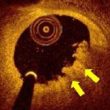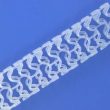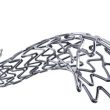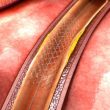Neoatherosclerosis was frequently observed in patients who experienced very late stent thrombosis, particularly those with drug-eluting stents. In-stent plaque rupture was the most common cause of thrombosis and it usually occurred in cases in which the original procedure had been carried out while the patient was undergoing an acute myocardial infarction. Macrophage infiltration can be...
ACC 2018 | COMBO: New Stent with Thin Struts and Pro-Healing Membrane
The new COMBO stent, comprised of thin struts plus a bioengineered layer of endothelial progenitor cells, is safe and effective at 1 year, according to this registry (the largest study on this device to date). This new stent could provide a better option for patients at high risk for bleeding who may not be able to...
OCT Follow-Up of Plaque Erosion with Medical Therapy and Without Stenting
Most acute coronary syndromes (ACS) are caused by the following three different pathologies: Plaque rupture Plaque erosion Calcified nodule In daily clinical practice, all patients who experience them are treated with angioplasty, regardless of which of these physiopathologies led to the ACS in each case. Some early reports indicate that patients with plaque erosion might...
DARE: Drug-Coated Balloons Compete with DES for the Treatment of In-Stent Restenosis
Courtesy of the Brazilian Society of Hemodynamics and Interventional Cardiology (SBHCI). The SeQuent Please paclitaxel-coated balloon provides non-inferior angiographic results when compared with the Xience everolimus-eluting stent for the treatment of in-stent restenosis. At 6 months, the minimal lumen diameter was 1.71 mm in the drug-coated balloon arm and 1.74 mm in the Xience arm, a difference that...
SYNTAX II: Better Stents, IVUS, FFR, or a Combination of All of Them to Catch Up with Surgery
In patients with 3-vessel disease, surgery obtained better outcomes than angioplasty, according to results from the SYNTAX and FREEDOM trials, which used first-generation drug-eluting stents. Even in the BEST trial, which used new-generation stents, surgery still offered far better outcomes. Nobody is surprised by the fact that, whenever angioplasty evolves due to a new device...
Are Bioresorbable-Polymer Stents More Thrombogenic than Durable-Polymer Second-Generation Stents?
Courtesy of Dr. Cristian Jesús Rodríguez. Most stents currently used in percutaneous coronary intervention (PCI) are durable-polymer second-generation drug-eluting stents (DP-DES, with everolimus or zotarolimus). However, it has been argued that the persistence of such a polymer after complete drug elution is one of the main factors for a dangerous complication: stent thrombosis (ST). After...
Biodegradable-polymer stents are as safe as permanent-polymer stents in a 5-year follow-up
Courtesy of Dr. Carlos Fava. One of the questions around drug-eluting stents (DES) is whether the development of biodegradable polymers would derive in better outcomes than the performance of durable polymers as regards the presence of events. In consequence, the COMPARE II trial was carried out with the aim of testing them in “real-world” patients. This...
EVOLVE II: Diabetes Substudy: Results at 3 Years after the SYNERGY Stent in Diabetics
Courtesy of SBHCI Diabetic patients have worse evolution after coronary PCI. Drug eluting stents with bioresorbable polymers were designed to facilitate arterial healing, and reduce inflammation and late and very late thrombosis risk. This sub-study of diabetic EVOLVE II patients presents the 3 year outcomes of the SYNERGY stent. The EVOLVE II included...
DESSOLVE III: Xience vs. MiStent
The MiStent device is made of cobalt-chromium, with struts of up to 64 µm thick. It is coated with a completely absorbable polymer that contains a microcrystalline form of sirolimus that embeds directly into the vessel wall. The drug is eluted continuously for up to 9 months. This was a multicenter noninferiority study that randomized patients...
Promising Outcomes of Overlapping Stents in Patients Undergoing Bioresorbable Scaffold (BRS) Implantation
Courtesy of Dr. Guillermo Migliaro. In regular clinical practice, overlapping stents are reported in up to 30% of patients undergoing coronary angioplasty, especially due to very long lesions requiring implantation of multiple stents or dissection after the implantation of a first stent. In bare metal stent era, overlapping was associated with unfavorable clinical outcomes...









